Related Research Articles

Moctezuma I, also known as Moteuczomatzin Ilhuicamina, Huehuemoteuczoma or Montezuma I, was the second Aztec emperor and fifth king of Tenochtitlan. During his reign, the Aztec Empire was consolidated, major expansion was undertaken, and Tenochtitlan started becoming the dominant partner of the Aztec Triple Alliance. Often mistaken for his popular descendant, Moctezuma II, Moctezuma I greatly contributed to the famed Aztec Empire that thrived until Spanish arrival, and he ruled over a period of peace from 1440 to 1453. Moctezuma brought social, economical, and political reform to strengthen Aztec rule, and Tenochititlan benefited from relations with other cities.

The Aztecs were a Mesoamerican culture that flourished in central Mexico in the post-classic period from 1300 to 1521. The Aztec peoples included different ethnic groups of central Mexico, particularly those groups who spoke the Nahuatl language and who dominated large parts of Mesoamerica from the 14th to the 16th centuries. Aztec culture was organized into city-states (altepetl), some of which joined to form alliances, political confederations, or empires. The Aztec Empire was a confederation of three city-states established in 1427: Tenochtitlan, city-state of the Mexica or Tenochca; Texcoco; and Tlacopan, previously part of the Tepanec empire, whose dominant power was Azcapotzalco. Although the term Aztecs is often narrowly restricted to the Mexica of Tenochtitlan, it is also broadly used to refer to Nahua polities or peoples of central Mexico in the prehispanic era, as well as the Spanish colonial era (1521–1821). The definitions of Aztec and Aztecs have long been the topic of scholarly discussion ever since German scientist Alexander von Humboldt established its common usage in the early nineteenth century.

In Aztec mythology, Xochiquetzal, also called Ichpochtli Classical Nahuatl: Ichpōchtli[itʃˈpoːtʃtɬi], meaning "maiden", was a goddess associated with fertility, beauty, and love, serving as a protector of young mothers and a patroness of pregnancy, childbirth, and the crafts practiced by women such as weaving and embroidery. In pre-Hispanic Maya culture, a similar figure is Goddess I.

Tlahuizcalpantecuhtli[t͡ɬaːwisˈkaɬpantekʷt͡ɬi] is a principal member of the pantheon of gods within the Aztec religion, representing the Morning Star Venus. The name comes from the Nahuatl words tlāhuizcalpan[t͡ɬaːwisˈkaɬpan] "dawn" and tēuctli[ˈteːkʷt͡ɬi] "lord". Tlahuizcalpantecuhtli is one of the thirteen Lords of the Day, representing the 12th day of the Aztec trecena.

Xōchipilli[ʃu˕ːt͡ʃiˈpiɬːi] is the god of art, games, dance, flowers, and song in Aztec mythology. His name contains the Nahuatl words xōchitl ("flower") and pilli and hence means "flower prince".

In Aztec mythology, Centeōtl[senˈteoːt͡ɬ] is the maize deity. Cintli[ˈsint͡ɬi] means "dried maize still on the cob" and teōtl[ˈteoːt͡ɬ] means "deity". According to the Florentine Codex, Centeotl is the son of the earth goddess, Tlazolteotl and solar deity Piltzintecuhtli, the planet Mercury. Born on the day-sign 1 Xochitl. Another myth claims him as the son of the goddess Xochiquetzal. The majority of evidence gathered on Centeotl suggests that he is usually portrayed as a young man, with yellow body colouration. Some specialists believe that Centeotl used to be the maize goddess Chicomecōātl. Centeotl was considered one of the most important deities of the Aztec era. There are many common features that are shown in depictions of Centeotl. For example, there often seems to be maize in his headdress. Another striking trait is the black line passing down his eyebrow, through his cheek and finishing at the bottom of his jaw line. These face markings are similarly and frequently used in the late post-classic depictions of the 'foliated' Maya maize god.

In Aztec mythology, Tlazolteotl is a deity of vice, purification, steam baths, lust, filth, and a patroness of adulterers. She is known by three names, Tlahēlcuāni and Tlazōlmiquiztli, and Ixcuina or Ixcuinan, the latter of which refers to a quadripartite association of four sister deities.

In Aztec mythology, Cihuacōātl[siwaˈkoːaːt͡ɬ] was one of a number of motherhood and fertility goddesses. Cihuacōātl was sometimes known as Quilaztli.

In Aztec mythology, Xiuhtecuhtli[ʃiʍˈtekʷt͡ɬi], was the god of fire, day and heat. He was the lord of volcanoes, the personification of life after death, warmth in cold (fire), light in darkness and food during famine. He was also named Cuezaltzin[kʷeˈsaɬt͡sin] ("flame") and Ixcozauhqui[iʃkoˈsaʍki], and is sometimes considered to be the same as Huehueteotl, although Xiuhtecuhtli is usually shown as a young deity. His wife was Chalchiuhtlicue. Xiuhtecuhtli is sometimes considered to be a manifestation of Ometecuhtli, the Lord of Duality, and according to the Florentine Codex Xiuhtecuhtli was considered to be the father of the Gods, who dwelled in the turquoise enclosure in the center of earth. Xiuhtecuhtli-Huehueteotl was one of the oldest and most revered of the indigenous pantheon. The cult of the God of Fire, of the Year, and of Turquoise perhaps began as far back as the middle Preclassic period. Turquoise was the symbolic equivalent of fire for Aztec priests. A small fire was permanently kept alive at the sacred center of every Aztec home in honor of Xiuhtecuhtli.

In Aztec religion, Huixtocihuatl was a fertility goddess who presided over salt and salt water. The Aztecs considered her to be the older sister of the rain gods, including Tlaloc. Much of the information known about Huixtocihuatl and how the Aztecs celebrated her comes from Bernardino de Sahagún's manuscripts. His Florentine Codex explains how Huixtocihuatl became the salt god. It records that Huixtocihuatl angered her younger brothers by mocking them, so they banished her to the salt beds. It was there where she discovered salt and how it was created. As described in the second book of the Florentine Codex, during Tecuilhuitontli, the seventh month of the Aztec calendar, there was a festival in honor of Huixtocihuatl. The festival culminated with the sacrifice of Huixtocihuatl's ixiptla, the embodiment of the deity in human form.
In the context of creation myths, the term Five Suns describes the doctrine of the Aztec and other Nahua peoples in which the present world was preceded by four other cycles of creation and destruction. It is primarily derived from the mythological, cosmological and eschatological beliefs and traditions of earlier cultures from central Mexico and the Mesoamerican region in general. The Late Postclassic Aztec society inherited many traditions concerning Mesoamerican creation accounts, while modifying some aspects and supplying novel interpretations of their own.

In Aztec mythology, Huehuecóyotl[weːweˈkojoːt͡ɬ] is the auspicious Pre-Columbian god of music, dance, mischief, and song. He is the patron of uninhibited sexuality and rules over the day sign in the Aztec calendar named cuetzpallin (lizard) and the fourth trecena Xochitl.

The Aztec religion originated from the indigenous Aztecs of central Mexico. Like other Mesoamerican religions, it also has practices such as human sacrifice in connection with many religious festivals which are in the Aztec calendar. This polytheistic religion has many gods and goddesses; the Aztecs would often incorporate deities that were borrowed from other geographic regions and peoples into their own religious practices.

The Feathered Serpent was a prominent supernatural entity or deity, found in many Mesoamerican religions. It is still called Quetzalcoatl among the Aztecs, Kukulkan among the Yucatec Maya, and Q'uq'umatz and Tohil among the K'iche' Maya.

Aztec clothing are the fiber of clothing that were worn by the Aztecs peoples during their time that varied based on aspects such as social standing and gender. The garments worn by Aztec peoples were also worn by other pre-Columbian peoples of central Mexico who shared similar cultural characteristics. The strict sumptuary laws present in Aztec society had dictated the type of fiber and ornamentation present in clothing, as well as how that clothing was worn based on class. Clothing and cloth were immensely significant in the culture.

Quetzalcoatl is a deity in Aztec culture and literature whose name comes from the Nahuatl language and means "Precious serpent" or "Quetzal-feathered Serpent". In the 17th century, Ixtlilxóchitl, a descendant of Aztec royalty and historian of the Nahua people, wrote, "Quetzalcoatl, in its literal sense, means 'serpent of precious feathers', but in the allegorical sense, 'wisest of men'."

In Aztec mythology, Piltzintecuhtli[piɬt͡sinˈtekʷt͡ɬi] was a god of the rising sun, healing, and visions, associated with Tōnatiuh. The name means "the Young Prince". It may have been another name for Tōnatiuh, but he is also mentioned as a possibly unique individual, the husband of Xōchiquetzal. He was the lord of the third hour of the night. Piltzintecuhtli was said to be the son of Oxomoco and Cipactonal and was seen as a protector of children. He was identified as the Youthful Sun.

Mexican featherwork, also called "plumería", was an important artistic and decorative technique in the pre-Hispanic and colonial periods in what is now Mexico. Although feathers have been prized and feather works created in other parts of the world, those done by the amanteca or feather work specialists impressed Spanish conquerors, leading to a creative exchange with Europe. Featherwork pieces took on European motifs in Mexico. Feathers and feather works became prized in Europe. The "golden age" for this technique as an art form was from just before the Spanish conquest to about a century afterwards. At the beginning of the 17th century, it began a decline due to the death of the old masters, the disappearance of the birds that provide fine feathers and the depreciation of indigenous handiwork. Feather work, especially the creation of "mosaics" or "paintings" principally of religious images remained noted by Europeans until the 19th century, but by the 20th century, the little that remained had become a handcraft, despite efforts to revive it. Today, the most common feather objects are those made for traditional dance costumes, although mosaics are made in the state of Michoacán, and feather trimmed huipils are made in the state of Chiapas.
Xochitlicue is the goddess of fertility, patroness of life and death, guide of rebirth, younger sister of Coatlicue, Huitzilopochtli's mother according Codex Florentine; and Chimalma, Quetzalcoatl's mother according Codex Chimalpopoca. One of the three daughters of Tlaltecuhtli and Tlalcihuatl, the couple of the earth gods created by the Tezcatlipocas.